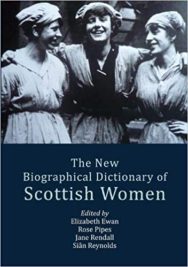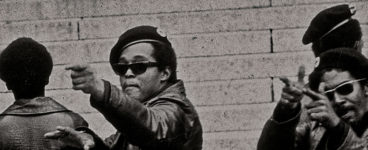Who was ‘the Red Harlot of Infidelity’?
Edinburgh University Press have just released a fully revised and extended edition of their highly regarded reference work that illuminates the lives of Scottish women in history. And there are plenty of rebels to be found in these pages. We have a little taster, two of the new additions to the dictionary, two amazing life stories here on BooksfromScotland. There are so many inspirational women to be found in the dictionary; you’ll just have to buy a copy to find your next Scottish heroine!
Extract taken from The New Biographical Dictionary of Scottish Women
Edited by Elizabeth Ewan, Rose Pipes, Jane Rendall and Siân Reynolds
Published by Edinburgh University Press
SULTER, Maud, born Glasgow 19 Sept. 1960, died Dumfries 27 Feb. 2008.
Visual artist, photographer, writer, cultural activist. Daughter of Elsie Sulter, tramcar conductress, and Claud Ennin, eye surgeon and diplomat.
Of Scottish and Ghanaian descent, Maud Sulter left Glasgow at 17 to attend the London College of Fashion, later graduating with MA in Photographic Studies at the University of Derby. A cultural polymath, she co-founded and was active in a range of Black feminist and lesbian projects from the early 1980s, and was uncompromising in her indictment of the inequalities that dogged the creative endeavours of Black women, both historically and in contemporary culture. Her work across several genres explored the terrain of colonialism, the erasure of Black women’s history and the enduring presence of Africa in Europe.
From the landmark The Thin Black Line exhibition curated by Lubaina Himid (ICA, London, 1986), to her inclusion in the Johannesburg Biennial (1995), Maud Sulter’s work was widely shown, and is in many private and public collections including the NPG, SNPG, Scottish Parliament and Victoria and Albert Museum. She was the recipient of a Momart fellowship at Tate Liverpool (1990).
Maud Sulter joined Lubaina Himid as codirector of the influential Elbow Room Gallery at the end of the 1980s. As both curator and editor, she showcased her own work and that of other Black women creatives in ground-breaking exhibitions such as Zabat (1989) and Syrcas (1993), and publications including Passion: discourses on blackwomen’s creativity (1990). Her photographic works and montages, such as Hysteria (1991), Les Bijoux (2002) and Jeanne Duval: a melodrama (2003) are increasingly read as pioneering (see Cherry 2015). Alongside academic writing, she published a play,
Service to Empire (2002), and several collections of poetry: As a Blackwoman (1985, which won the Vera Bell Prize); Zabat: poetics of a family tree (1989); and Sekhmet (2005). A prolific prose writer, she contributed many essays to magazines and journals as well as exhibition catalogues. In her final years, Maud Sulter, who had three children, returned to Scotland, a country to which she remained closely connected. She died from cancer aged 47.
WRIGHT, Frances (Fanny), m. Phiquepal d’Arusmont, born Dundee 6 Sept. 1795, died Cincinnati, Ohio 13 Dec. 1852.
Utopian socialist, feminist, freethinker. Daughter of Camilla Campbell, and James Wright, radical Dundee merchant.
Both parents having died in 1798, Fanny and her sister Camilla Wright (1797–1831), after childhood in London and Devon, stayed with their great-uncle James Mylne, Professor of Moral Philosophy at Glasgow, and his wife Agnes Millar. Fanny Wright educated herself in the university library, writing a treatise on an imagined female disciple of Epicurus, A Few Days in Athens (1822), and several plays, including Altorf (1819). Through the influence of sisters Robina Millar and *Margaret Cullen, she was attracted by the example of the American republic. In 1818, she and Camilla travelled there: in February 1819 Altorf was staged on Broadway. On her return, she published her letters to Robina Millar as Views of Society and Manners in America (1821), greeted with enthusiasm by The Scotsman, but viewed by the Quarterly Review as a ‘ridiculous and extravagant panegyric on the government and people of the United States’ (Eckhardt 1984, pp. 47–8). Fanny Wright criticised the republic only for the institution of slavery, and, to a lesser extent, its treatment of women. In Paris in 1821, she met the Marquis de Lafayette, veteran of the American and French Revolutions, to whom she became devoted. With Camilla, she returned to the USA to join him in 1824, and was further inspired by Robert Owen’s new community at New Harmony, Indiana. At Nashoba, Tennessee, from 1825, she planned first a model farm, of which both she and Camilla were resident trustees, based on the labour of purchased black slaves, then a utopian community, following Owen’s ideas. Though initially successful, in July 1827 Nashoba received unwelcome publicity about inter-racial sex, suggesting this was approved by the Wright sisters.
Back in Europe, Fanny Wright met the ensuing storm of disapproval by publicly justifying a co-operative, biracial community of equals, and condemning oppressive laws on marriage and attitudes to miscegenation. Returning in December 1827, she found Nashoba failing economically and in its ideals and Camilla newly married. Fanny Wright joined Owen’s son, Robert Dale Owen, in New Harmony, becoming joint editor of the New Harmony Gazette (later Free Enquirer). Unprecedentedly, she also began to lecture to large mixed audiences across the US on anti-slavery and co-operation, free thought and marriage reform. Opponents labelled her ‘the Red Harlot of Infidelity’ (Eckhardt 1984, p. 3). In 1829 the Wright sisters and Robert Dale Owen moved to New York, drawn by the situation of urban artisans and the New York Working Men’s Party. Having taken her freed slaves to Haiti, accompanied by a former Nashoba settler, William Phiquepal (b. 1811), Fanny Wright became pregnant with his child, and returned to France in June 1830. Camilla followed, but died in Paris in childbirth in February 1831. Fanny married Phiquepal in 1831, after the birth of her daughter Sylva. Her later years were spent in poverty in France and the USA, often separated from husband and daughter, writing her autobiography and her major work, England the Civiliser (1848). In 1844 she inherited property in Dundee, but her husband’s financial demands led to a divorce suit, estrangement from her daughter, and legal conflict until her death in 1852. Fanny Wright’s portrait became the frontispiece of the six-volume History of Woman Suffrage in a sincere tribute to ‘the first woman who gave lectures on political subjects in America’ and spoke ‘on the equality of the sexes’ (Stanton et al., 1881, I, pp. 35, 691–2; II, 429; III, 293).
The New Biographical Dictionary of Scottish Women edited by Elizabeth Ewan, Rose Pipes, Jane Rendall and Siân Reynolds is published by Edinburgh University Press, priced £35.00















